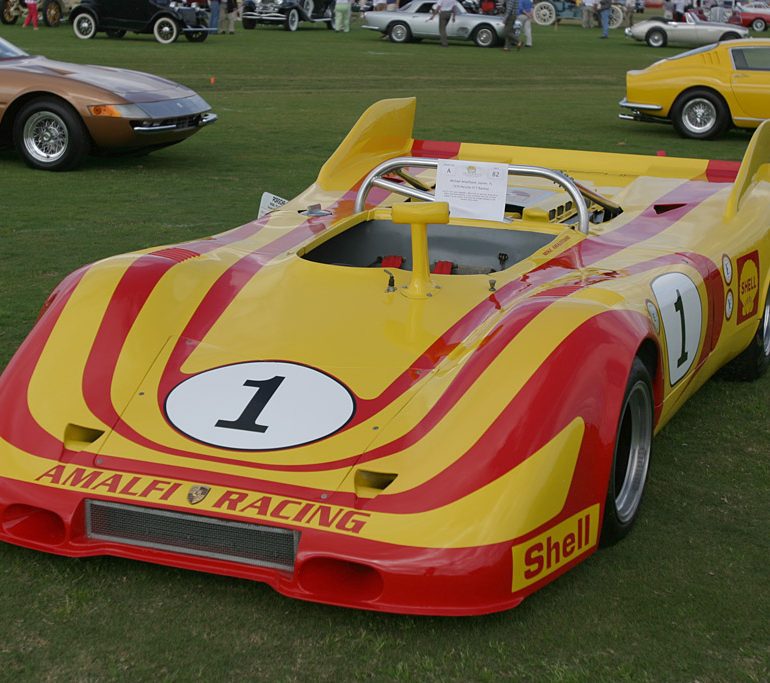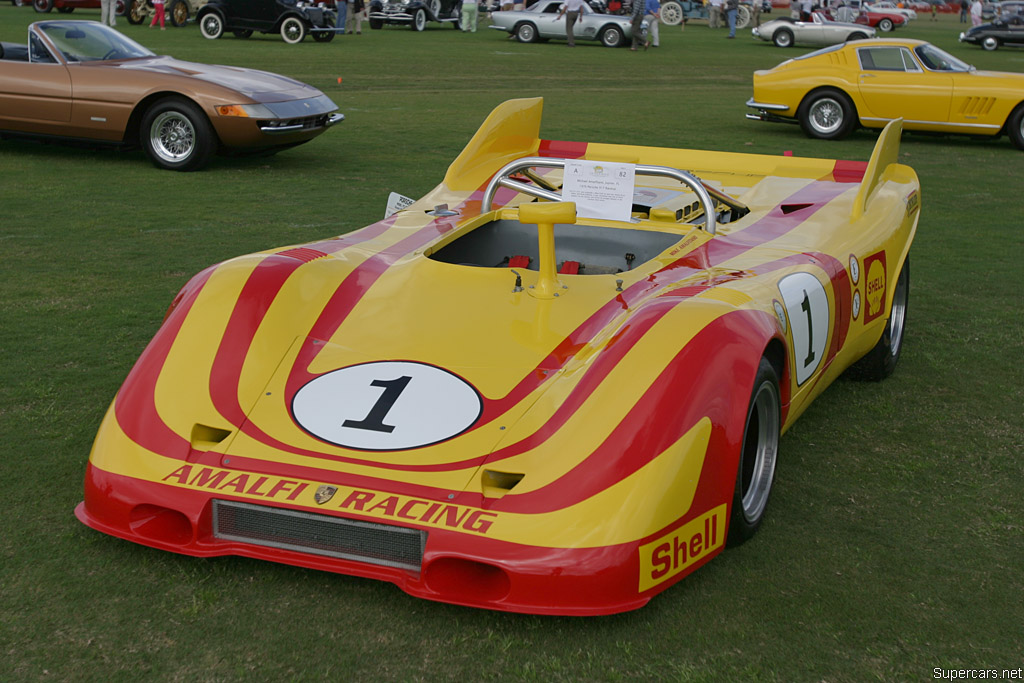1970 Porsche 917 ‘Interserie Spyder’
Of all the 917 variants, the ‘Interserie Spyder’ was one of the most successful. It won the Interserie championship outright for two years in a row before the model was replaced by the 917/10 of 1972. Three lightweight 917 Spyders were prepared by Porsche specifically for the Interserie, a new European-based racing series that mimicked the Can-Am rules from North America. Since it was initially run under Group 7 regulations, Porsche could remove the roof and make the design even more potent.
Under the spyder body was essentially the same design which won the 1970 24 Hours of Le Mans outright. This included the car’s lightweight aluminum space frame and the potent flat-12 engine in the rear. The Spyder bodywork was similar to a sole car made for the 1969 Can-Am that was called the 917PA.
Since the Interserie put a new lease on life for a number of cars which became redundant in the World Championship of Makes, the grids were diverse. Cars such as the Alfa 33, Ferrari 512M and Porsche 917 competed with new Group 7 designs from McLaren and March.
The first year in 1970 was a resounding victory for Porsche and the 917 Spyder with Jürgen Neuhaus taking two outright victories in six races. Not far behind was Gijs Van Lennep who placed second in the series with another 917. In 1971 Leo Kinnunen won the series with his 917 Spyder which was the beginning of his three year dominance driving for Porsche.
In Detail
| type | Racing Car |
| built at | German |
| body stylist | Gerhard Schroeder |
| engineers | Helmut Flegl, Paul Hensler |
| production | 3 |
| engine | Air Cooled 912.10 180º Flat-12 w/Dry Sump Lubrication |
| position | Stressed Mid Longitudinal |
| aspiration | Natural |
| block material | Light Metal w/Hard Chromed Cylinders |
| valvetrain | Gear Driven DOHC, 2 Valves per Cyl |
| fuel feed | Bosch Fuel Injection |
| displacement | 4494 cc / 274.24 in³ |
| bore | 85 mm / 3.35 in |
| stroke | 66 mm / 2.60 in |
| compression | 10.5:1 |
| engine designer | Hans Mezger |
| power | 432.51 kw / 580 bhp @ 8000 rpm |
| specific output | 129.06 bhp per litre |
| bhp/weight | 725.0 bhp per tonne |
| torque | 562.66 nm / 415 ft lbs @ 6400 rpm |
| body / frame | Polyester & Fiberglass Panels over Aluminum Spaceframe |
| driven wheels | RWD w/LSD |
| front tires | 4.75/11.30-15 Dunlop |
| rear tires | 6.0/13.50-15 Dunlop |
| front brakes | Internally Vented Discs w/Dual-Circuit Calipers |
| rear brakes | Internally Vented Discs w/Dual-Circuit Calipers |
| front wheels | F 38.10 x 22.86 cm / 15 x 12 in |
| rear wheels | R 38.10 x 30.48 cm / 15 x 12 in |
| steering | Rack & Pinion |
| f suspension | Arms w/Coil Springs, Bilstein Shocks |
| r suspension | Arms w/Coil Springs, Bilstein Shocks |
| curb weight | 800 kg / 1764.00 lbs |
| wheelbase | 2300 mm / 90.55 in |
| front track | 1488 mm / 58.58 in |
| rear track | 1457 mm / 57.36 in |
| length | 4140 mm / 162.99 in |
| width | 1980 mm / 77.95 in |
| height | 920 mm / 36.22 in |
| transmission | 5-Speed Manual |
Chassis
Resurrected by the Porsche factory from one of three 1970 Le Mans cars entered by Gulf-JW Automotive. The chassis was nearly written off near the pitlane straight, but Porsche rebuilt the badly damaged hulk into a Spyder and restamped the chassis into 031. In this configuration it was campaigned by the German owner/driver Ernst Kraus and subsequently by Georg Loos’ Gelo Racing Team for well-known Porsche exponent Jurgen Barth.Later, the car became part of the Amalfitano collection in 1987 and was used at several high-end events.
Sources & Further Reading
Bamsey, Ian.Porsche 917 Kurz. Langheck. Spyder. Foulis & Co ltd, 1987.
Hinsdale, Peter.The Fabulous Porsche 917. Haessner Publishing, 1976.
Ludvigsen, Karl.Excellence Was Expected. Princeton Publishing Inc. Princeton, 1977.
Morgan, Peter.Porsche 917: The Winning Formula. Haynes, 1999.
Auction Sales History
1972-73 Porsche 917 Interserie Spyder. Ex-Ernst Kraus/Jurgen Barth 1972-73 European Interserie and David Hobbs/Mike Hailwood Gulf-JW Automotive. Auction Source: Bonhams 2010 Exceptional Motorcars and Automobilia





